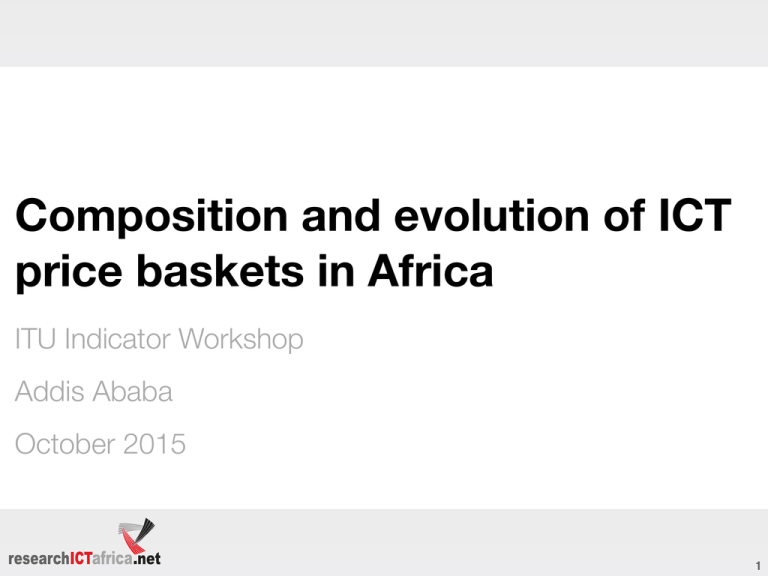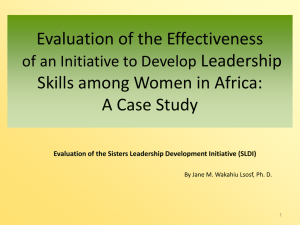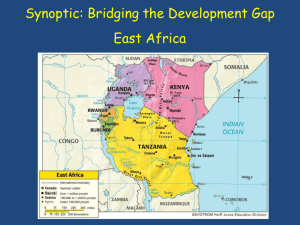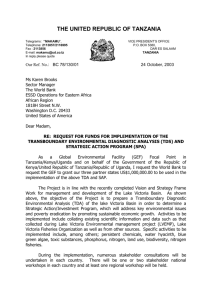Composition and evolution of ICT price baskets in Africa ITU Indicator Workshop
advertisement

Composition and evolution of ICT price baskets in Africa ITU Indicator Workshop Addis Ababa October 2015 1 Intro ‣ Evolution: From baskets to bundles ‣ Pricing in the African context is unique ‣ How do we capture data in a dynamic market? ‣ Enter: RAMP - RIA Africa Mobile Pricing Index • 46 African countries • Updated quarterly 2 RAMP - RIA Africa Mobile Pricing Index 1. Africa Prepaid Pricing Index 1. Baskets - Origin 2. Changes 2. Bundled Value Index 1. Market Evolution 3. Postpaid Value Index 4. Mobile Broadband (Data) Value Index 3 1 - Africa Prepaid Pricing Index 4 OECD (2010) Mobile Basket Methodology 40 calls/60 SMS prepaid monthly ‣ Pricing products for baskets of minutes and SMS ‣ At least two largest mobile operators based on subscribers numbers • The operators covered should have between them at least 50% market share ‣ Cheapest products for country comparison 5 Basket Methodology Weaknesses ‣ Baskets do not reflect the most popular package but the cheapest product ‣ The same basket is used for all operators: offnet/on-net ratio depends on market share ‣ Only the two largest mobile operators - new entrants and small operators are likely to be price challengers 6 Expanding OECD Methodology to all operators and all products in a country Comparing Countries OECD Basket Methodology Comparing Operators Comparing Products 7 Comparing countries Comparing cheapest product available from dominant operators cheapest operator most expensive operator Comparing the difference between cheapest in country - cheapest from dominant operators cheapest in country - cheapest from most expensive operator Benchmarking 8 Cheapest Prepaid product in country in US$ Q2 2014 Dominant operator Egypt Ghana Sudan Ethiopia Mauritius Kenya Rwanda Tunisia Algeria Libya South Africa Nigeria Uganda Sierra Leone Namibia Mozambique Botswana Benin 2.57 2.73 2.83 3.9 4.05 4.26 5.06 5.91 6.33 7 7.18 7.2 8.44 9.26 9.43 10.13 11.14 11.37 Egypt Ghana Sudan Ethiopia Mauritius Kenya Rwanda Tunisia Algeria Libya South Africa Nigeria Uganda Sierra Leone Namibia Mozambique Botswana Benin Cheapest operator 1.61 2.13 1.06 3.9 4.05 1.46 5.06 5.73 6.33 7 4.97 4.54 7.02 9.26 8.24 10.13 10.15 11.37 9 Alternative comparisons Cheapest dominant operator in Africa in USD Cheapest dominant operator in South Africa in USD SA Dominant Operator Rank 28 25 26 28 27 28 29 28 26 23 23 21 14 14 14 7.6 7.5 7.8 7.7 7.4 3.4 3.3 3.3 3.0 3.0 2.6 2.3 2.3 2.3 1.7 1.7 1.6 Q3 2013 Q4 2013 Q1 2014 Q2 2014 Q3 2014 Q4 2014 Q1 2015 Q2 2015 13 Q2 2013 12.4 11.7 11.1 10.9 10.2 Q1 2013 3.8 16 Q4 2012 3.8 Q2 2012 3.9 18 Q3 2012 15.0 15.6 14.9 14.6 13.9 Q1 2012 3.5 Q3 2011 3.8 Q2 2011 3.8 Q1 2011 Q4 2010 3.8 19 Q4 2011 17.5 17.3 17.8 17.0 Prices have remained the same in local currency for cheapest dominant Africa (Safaricom Kenya) and South Africa (MTN) African Prepaid Pricing Index SA operators rank lowly on the index when compared to other african markets Algeria and have introduced new cheaper products pushing down S.A’s rank Prepaid Pricing Methodology 12 13 The Bundled Value Index (BVI) 14 New bundle offerings Need for additional data (ARPU/MoU) to create new baskets 15 Bundle Value Index BVI looks at bundles that include voice or sms and data Bundled Value Index Products increase in Q2 2015 New pricing strategy for all operators in country except for SA, Kenya and Ghana Airtel Tanzania best performing in Q1 2015 toppled by Orange Kenya Q2 2015 South African products closer to bottom of the rank Ethiopia ranks quite low in terms of value compared to other operators (Q2 2015) Airtel Tanzania 79.71 Sudani 73.31 ZanTel 57.62 MTC 43.23 Tigo Ghana 39.38 Airtel Madagascar 25.80 Airtel Kenya 19.42 Telma 18.38 Airtel Uganda 18.02 Vodacom Tanzania 17.74 Orange Senegal MTN South Africa 15.94 14.84 Orange Madagascar 13.00 Tigo Tanzania 12.74 Orange Africell Uganda 12.16 Movicel 11.23 Cell C 9.79 MTN Uganda 5.76 EthioTelecom 2.85 TN Mobile 2.26 Q1 2015 BVI best operator Orange Kenya CV Movel Unitel (ex T-Mais Cape Verde) Yu Kenya Airtel Ghana Zanzibar Telecom Limited Smart Uganda Airtel Tanzania Tigo Tanzania Sudani Uganda Telecom MTC Smart Tanzania Vodafone Ghana Tigo Ghana Tigo Senegal Etisalat Egypt Inwi Airtel Madagascar Orange Senegal Airtel Kenya Vodacom Tanzania Telma Movitel Mozambique Airtel Uganda Orange Madagascar MTN Cameroon Vodafone Egypt MTN South Africa Orange Africell Uganda Movicel Mobilis Cell C Orange Cameroon Tigo MTN Uganda Orange Botswana MTN Nigeria Libertis (Gabon Telecom) Ethio Telco TN Mobile 259.7 197.1 197.1 171.9 144.9 115.7 107.3 89.9 87.2 73.4 61.7 58.5 56.0 53.9 46.0 43.9 38.3 33.5 28.5 26.6 20.2 20.0 19.7 19.4 19.1 18.7 18.2 18.2 13.6 12.9 11.9 10.1 10.1 6.9 6.2 6.1 5.8 4.5 3.9 2.9 2.3 Q2 2015 BVI best operator RIA’s Mobile Broadband Pricing Index 19 Prepaid Broadband Baskets ‣ Prepaid mobile broadband data bundles • 1GB baskets • 1MB baskets - outdated • 1 Day baskets, 1 week - uncapped data bundles valid for at least 8 hours of one day - converted to one month 20 Prepaid data market - Q2 2015 Increased countries we collect in Q2 2015 from 21 to 36 african countries Rwanda’s Tigo cheapest dominant operator 1GB price at USD4.39 Tanzania Zantel cheapest operator 1GB price Swaziland most expensive product offering on the 1GB price assessment Ethio Telecom is relatively cheap in terms of data in Q2 2015 Cheapest 1GB price USD Dominant operator in country Rwanda Mozambique Tunisia Tanzania Madagascar Niger Senegal Burkina Faso Kenya Ghana Sao Tome and Principe Ethiopia Benin Algeria Malawi Uganda Liberia South Africa Mali Mali Namibia Nigeria Togo Chad Cote d'Ivoire Zambia Cameroon Gabon Sierra Leone Sudan Angola Lesotho Bostwana Zimbabwe Swaziland 4.4 4.4 5.2 1GB price USD Cheapest operator in country Tanzania Kenya Rwanda 8.0 Mozambique Ghana 8.1 Tunesia 8.4 Sudan 8.4 Mauritius 8.4 Malawi 9.0 South Africa 9.1 Niger 9.1 Togo 9.8 Senegal 10.1 Burkina Faso 10.2 Nigeria 10.6 Sao Tome and Principe 11.6 Uganda 12.0 Ethiopia 12.3 Benin 12.6 Algeria 12.6 Liberia 13.2 Mali 16.7 Mali 16.9 Namibia 16.9 Cameroon 16.9 Madagascar 18.0 Lesotho 20.2 Zambia 23.6 Gabon 24.0 Chad 24.4 Cote d'Ivoire Angola 24.4 Sierra Leone 27.3 Bostwana 30.9 Zimbabwe 35.0 Swaziland 37.7 3.8 4.3 4.4 4.4 4.5 5.2 5.8 7.3 8.1 8.2 8.4 8.4 8.4 8.4 9.1 9.1 9.3 9.8 10.1 10.2 12.0 12.6 12.6 13.2 13.5 14.6 14.9 16.5 16.9 16.9 16.9 22.6 24.0 28.3 30.0 37.7 Value for Money Index Discontinued 23 Download/Upload speed kbps Average Combined kbps Average Download kbps Average Upload kbps Safaricom Telecom Namibia Mobile Vodacom South Africa MTC Smile Nigeria Smile Tanzania MTN Uganda Vodacom Mozambique MTN Nigeria CellC Smile Uganda Airtel Ghana Orange Kenya MTN South Africa Vodafone Ghana Tigo Rwanda Orange Uganda Mascom Airrtel Rwanda MTN Rwanda Vodacom Tanzania Source: www.ookla.com Orange Botswana Airtel Uganda Airtel Nigeria Glo Mobile Ghana 0 10000 20000 30000 40000 50000 60000 24 0 Orange Botswana Glo Mobile Ghana Airtel Nigeria Airtel Uganda Mascom Botswana Tigo Rwanda Airtel Rwanda MTN Rwanda Vodacom Tanzania Orange Uganda MTN SA MTN Nigeria Vodafone Ghana Airtel Ghana Smile Uganda acom Mozambique MTN Namibia Orange Kenya Cell C SA MTN Uganda TN Mobile Namibia Smile Tanzania Smile Nigeria Vodacom SA Safaricom Kenya Q1 2014 - Value for money index Combined average speed in kbps/1GB price in USD 1600 1200 800 400 25 Postpaid Value Index (PVI) 26 The Postpaid Value Index Postpaid makes up a fairly small share of the mobile market in Africa The index only takes into account the top 12 economies with the highest share of postpaid Benchmarking within country (between operators) is just as important as benchmarking between countries 27 The Postpaid Value Index 28 Applied Example: South Africa 29 What do we do with all this information? Policy example 30 South Africa - Decline in MTR’s Cost of cheapest prepaid mobile product for OECD 40 calls/60 SMSs basket by operators in ZAR Telkom Mobile Virgin Mobile Cell C Vodacom South Africa MTN South Africa Amendment MTR 20c, asymmetry 44c 180 135 90 45 MTR 40c Q2 2014 Q1 2014 Q4 2013 Q3 2013 Q2 2013 Q1 2013 Q4 2012 Q3 2012 Q2 2012 Q1 2012 Q4 2011 Q3 2011 Q2 2011 Q1 2011 Q4 2010 0 31 Summary Aim is to protect the interest of the consumer For data to inform policy Collection is the easy part - All states should be doing this Data has to be carefully analyzed and understood in context of financial information and other supply and demand side indicator Continuously evolving market - indicators must evolve to keep up 32





